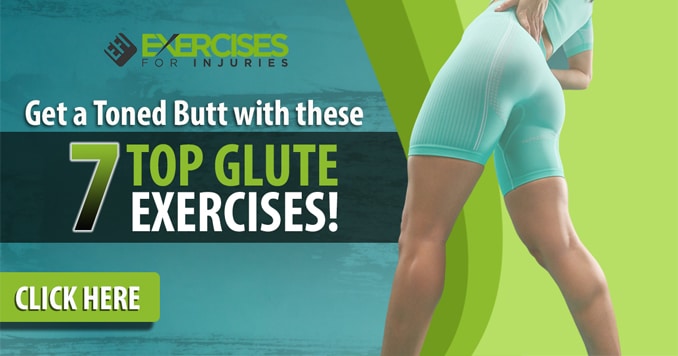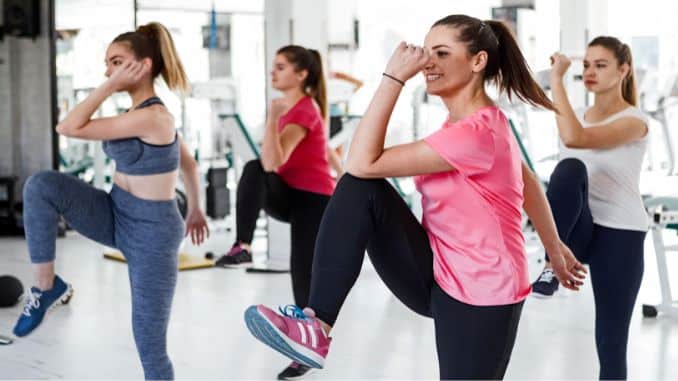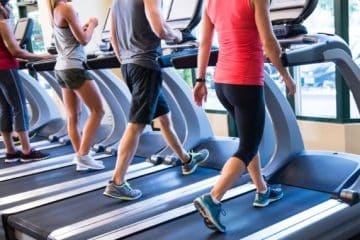Glute strength is important for both aesthetic and functional purposes.
The main responsibility of the glute is to keep us upright and push our bodies forward. They are critical for good pelvic alignment and propulsion as we walk and run; even when we stand on one leg, strong glutes are important.
The glute strengthening exercises in this post will not only make a difference in the appearance of your glutes, but you'll also experience a boost in confidence and overall fitness.
Let's dive in and unleash the power of your glutes!
Benefits and Importance of Having Strong Glutes
Glute strengthening is significant for various reasons.
1. Improving your overall body composition.
This is one of the most significant of strong hip muscles. The glutes are a large muscle group, which means they require a lot of energy to work. When you train your glutes, you burn a significant amount of calories, which can help you lose weight and build lean muscle mass.
2. They play a critical role in supporting the lower back, hips, and body.
Strong glutes help maintain proper posture and stability, preventing injuries and reducing pain in the lower back and knees.
3. Strong glutes are essential for athletic performance.
They are involved in almost every movement we make. These also enhance your agility, speed, and power, allowing you to perform better in sports and other physical activities.
4. Improve your confidence and self-esteem.
Having a toned butt is a desirable physical attribute that many people strive for, and achieving this can make you feel more attractive and confident in your skin.
Common Mistakes In Glute Exercises and How to Correct Them
Glute exercise is a fantastic way to strengthen and shape your posterior. Still, it's common for people to make a few mistakes along the way. Here are some of them:
1. Neglecting Proper Form
One of the most common mistakes is sacrificing proper form for heavier weights or more reps. While it may feel tempting to lift heavier, it's crucial to prioritize good form to target your glutes effectively.
Correction: Instead of rushing through your exercises, concentrate on each movement, focusing on your glute muscles. Visualize squeezing your glutes as you perform each rep, and ensure your form is correct before adding additional weight.
2. Over-Reliance on Isolation Exercises
Glute isolation exercises like donkey kicks or hip thrusts are popular choices, but solely relying on them may limit your progress. Glute workouts should incorporate a variety of compound exercises to engage multiple muscle groups simultaneously, leading to better overall strength and development.
Correction: Add compound exercises like squats, lunges, or deadlifts to your routine. These exercises work not only your glutes but also your quads and hamstrings, providing a more balanced and effective workout for your lower body.
3. Lack of Progressive Overload
Like any other muscle group, your glutes require progressive overload to grow and become stronger. Most people fall into the trap of sticking to the same weights and repetitions without challenging themselves. To see continual progress, you need to increase the intensity of your workouts gradually.
Correction:
-
- Keep a record of your exercises, weights, and reps.
- Aim to increase either the weight or the number of reps over time.
- Start with small increments and listen to your body's signals to avoid injury.
4. Insufficient Activation
Sometimes, the mind-muscle connection results in weak glutes, leading to inadequate activation during workouts. If you're not feeling the burn in your glutes, it might be because other muscles are compensating or taking over.
Correction: Before your glute strengthening exercises, warm up and activate your glutes with targeted activation exercises like glute bridges or clamshells. Focus on feeling the contraction in your glutes during these warm-up exercises to enhance the mind-muscle connection before moving on to your main workout.
Bootylicious: Simple Workouts to Sculpting Strong Glutes
Get ready to unleash your inner strength and confidence with these simple glute-strengthening exercises. But first, do the glute activation (Warm-Ups) exercises to maximize the benefits of the routine.
Warm-Ups
1. Shoulder Rolls
Begin in an upright standing position with your feet slightly wider than shoulder-width apart, maintaining good alignment with your head, shoulders, and hips. Place your hands on your side. Engage your core, bend your arms as you lift your shoulders, then pull your shoulders back, squeezing your shoulder blades together. Lower your shoulders to the starting position and repeat the movement. Start with 1 set of 10 – 15 repetitions in each direction.
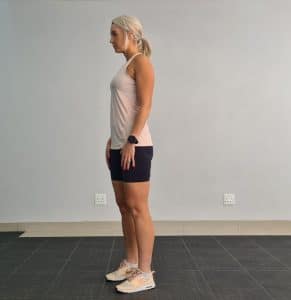 |
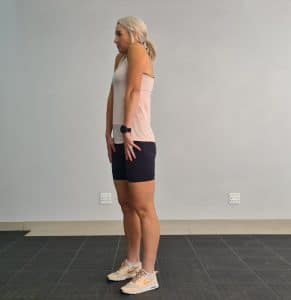 |
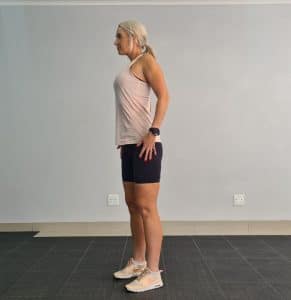 |
Shoulder Rolls
2. Arm Raises
Begin in an upright standing position with your feet slightly wider than shoulder-width apart, maintaining good alignment with your head, shoulders, and hips. Place your arms at your sides. Engage your core and raise both arms overhead, then slowly lower your arms to the starting position and repeat the movement. Complete 10 repetitions. Start with 2 sets of 10 repetitions.
 |
 |
Arm Raises
3. Lateral Lunge
Begin in an upright standing position with your feet shoulder-width apart, maintaining good alignment with your head, shoulders, hips, and legs. Place your hands on your thighs. Take one big step to the side with your left foot, then slightly bend your left knee and hinge your hips to lower your seat as you extend your right leg. Repeat the movement on the opposite side. Start with 1 set of 10 repetitions on each side.
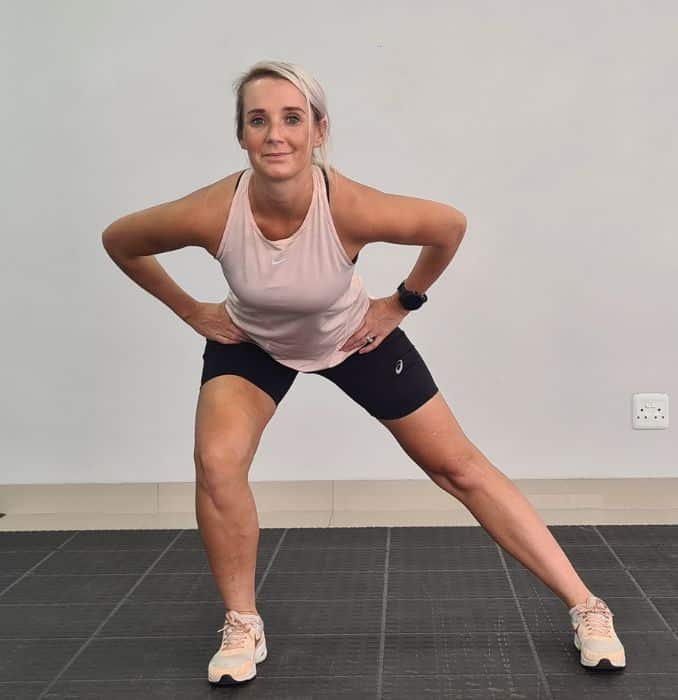 |
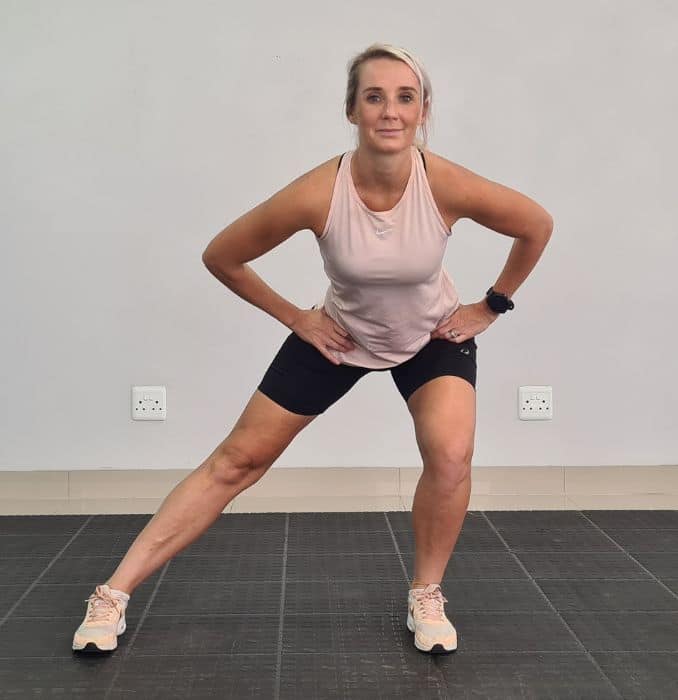 |
Lateral Lunge
4. Standing Hip Flexors Stretch
From the Side Lunge position, turn to your right side, maintaining good alignment with your head, shoulders, and hips. Place your hands on your hips. Tighten your abdominal muscles, then shift your hips forward and back by slightly bending and straightening your back knee. Complete 10 repetitions and repeat the movement on the opposite side.
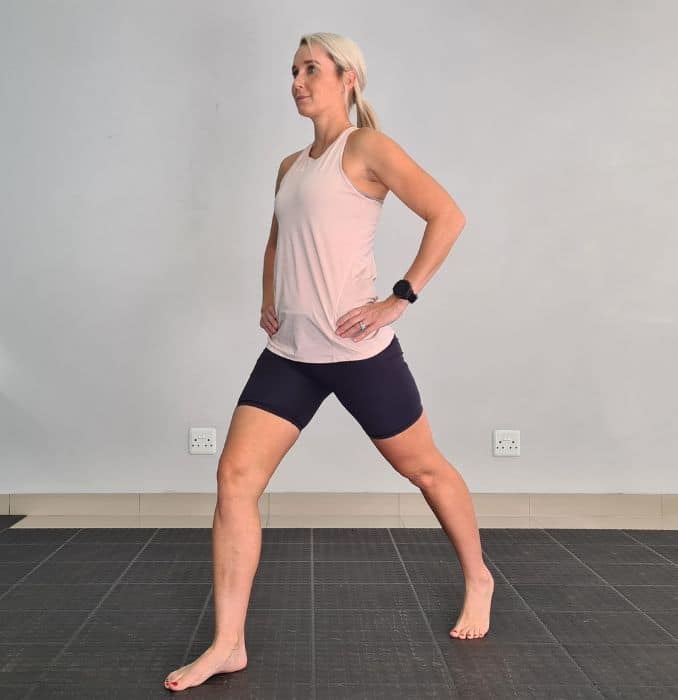 |
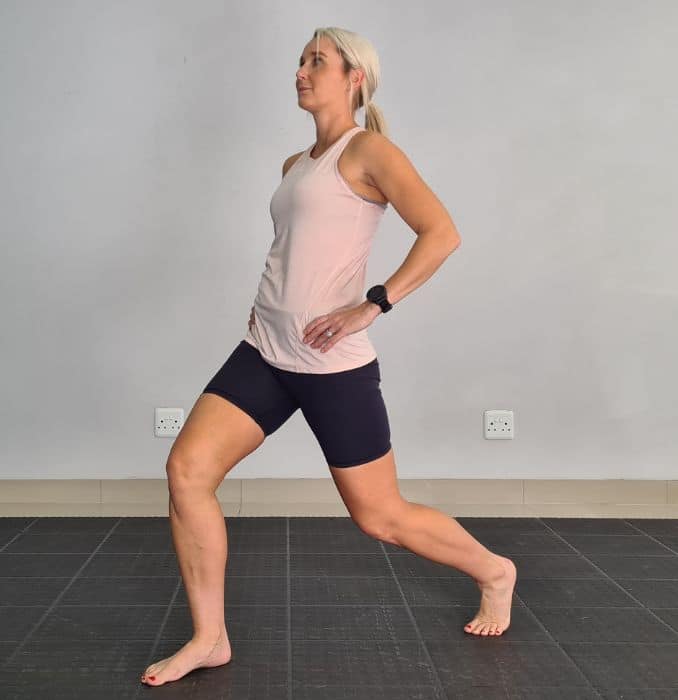 |
Standing Hip Flexors Stretch
Routine
1. Deadlifts
For this exercise, use a kettlebell or anything with weight like a jug of water or a bag of flour.
Begin in an upright standing position with your feet wider than shoulder-width apart, maintaining good alignment with your head, shoulders, and hips. Hold a kettlebell with both hands and engage your core. Hinge through your hips to bend your upper body forward with your knees slightly bent. Ideally, your back should be parallel to the floor. Raise back up to an upright standing position, squeezing your glutes at the top position. Repeat the movement. Complete 12 repetitions.
To make the exercise more challenging, increase the repetitions or the weight of your dumbbells.
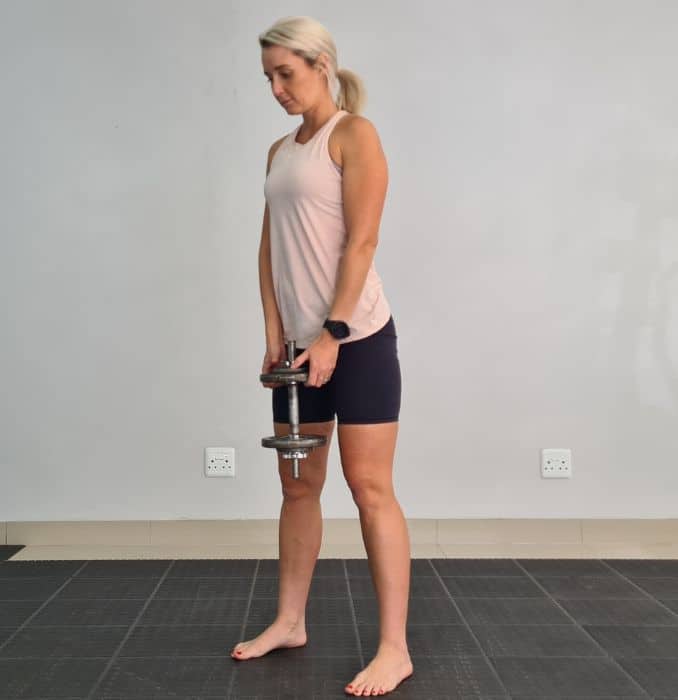 |
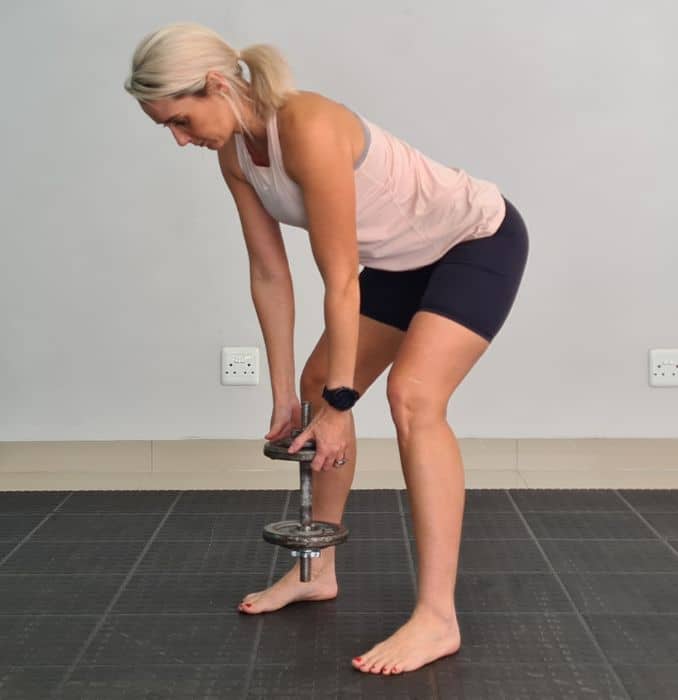 |
Deadlifts
2. Single Leg Deadlift
For this exercise, you can either perform the movement as bodyweight or you can utilize the wall, the back of the chair, or anything stable for balance if needed.
Begin in an upright standing position with your feet shoulder-width apart, maintaining good alignment with your head, shoulders, hips, and legs. Contract your abdominal muscles and slightly bend your left leg as you transfer all of your weight on one foot, then pivot through your hips to bend your upper body forward lifting your opposite leg. Ideally, your back and leg should be parallel to the floor and raise back up to return to the starting position. Complete 10 repetitions. Repeat the movement on the opposite side.
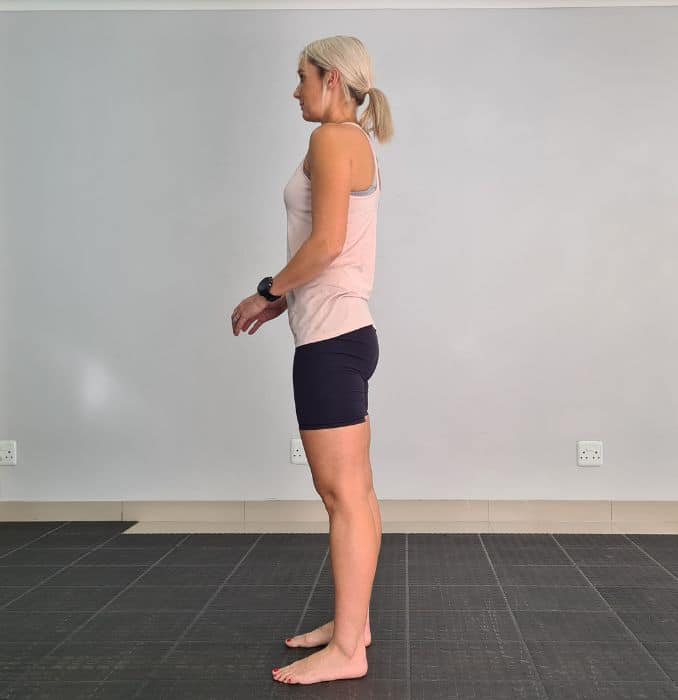 |
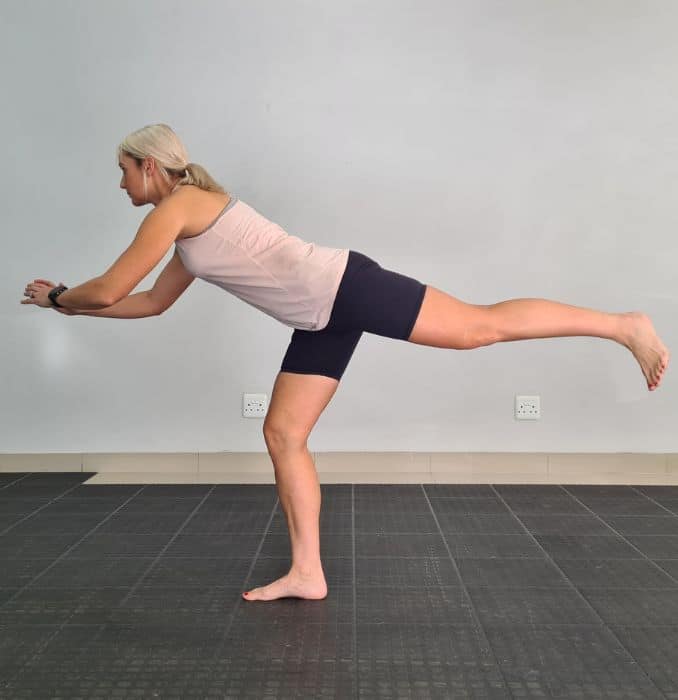 |
Single Leg Deadlift
3. Glute Bridges
For this exercise, use a platform or a couch for support.
Begin in an upright sitting position on the floor in front of a couch or a platform, maintaining good alignment with your head, shoulders, and hips. Then, lean back as you place your mid-back and arms on top of the couch with your knees bent and feet flat on the floor. Contract your abdominal area, then push from your heels to lift your hips, squeezing your glutes at the end position. Lower your hips to return to the starting position. Repeat the movements with 12 repetitions.
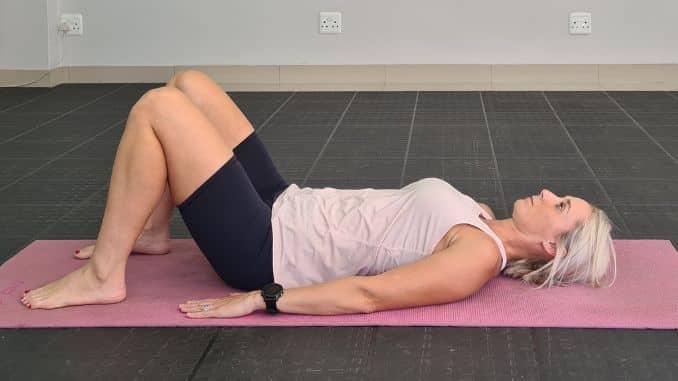 |
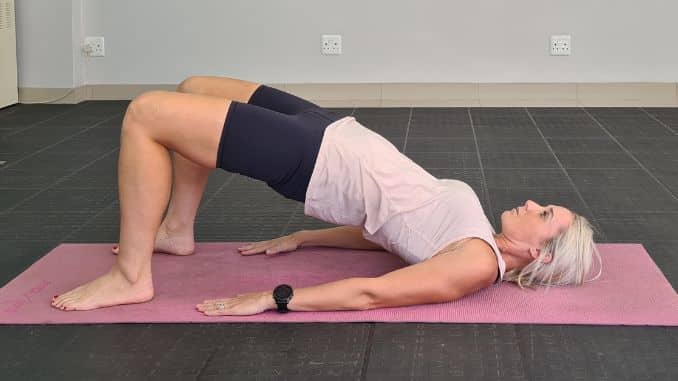 |
Glute Bridges
4. Glute Kickbacks
For this exercise, use a platform or hold on to the back of the chair, countertop, or anything stable for support and balance if needed.
Begin in a 4-point position with your hands beneath your shoulders and your knees under your hips, maintaining good alignment with your head, shoulders, hips, and toes. Engage your core. Shift your weight onto your right leg and kick the other leg straight back squeezing your glutes, then return to the starting position. Complete 12 repetitions and repeat the movement on the opposite side.
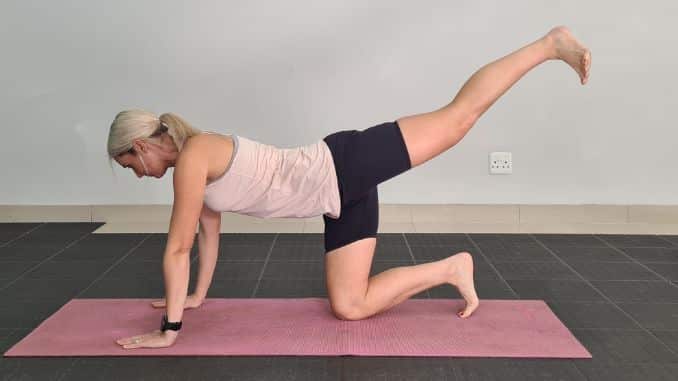
Glute Kickbacks
5. Lateral Leg Lifts
For this exercise, you can hold on to a countertop or place one hand against the wall for balance if needed.
Begin in an upright standing position with your feet hip-width apart, maintaining good alignment with your head, shoulders, hips, and legs. Tighten your abdominal area and lift your left leg out to the side, ideally to a 30 to 45-degree angle. Keep your toes pointing forward. Lower your left leg to return to the starting position. Complete 12 repetitions and repeat the movement on the opposite side.
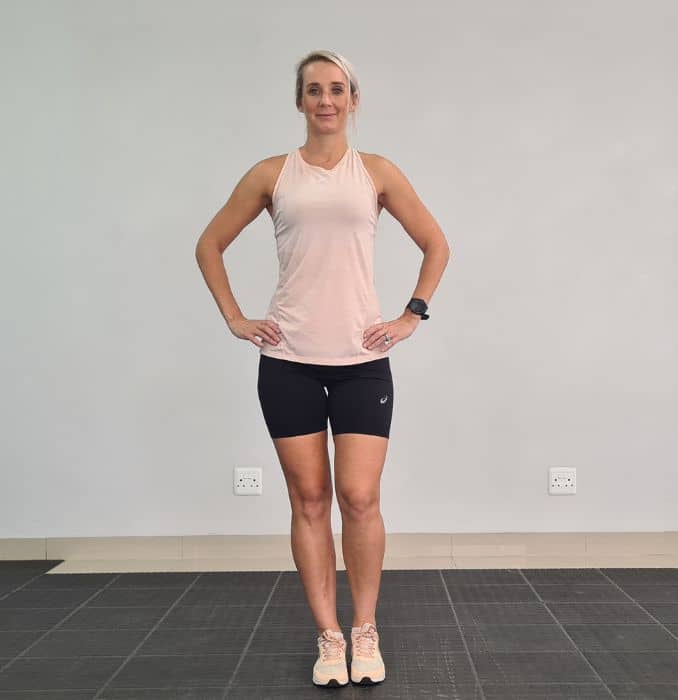 |
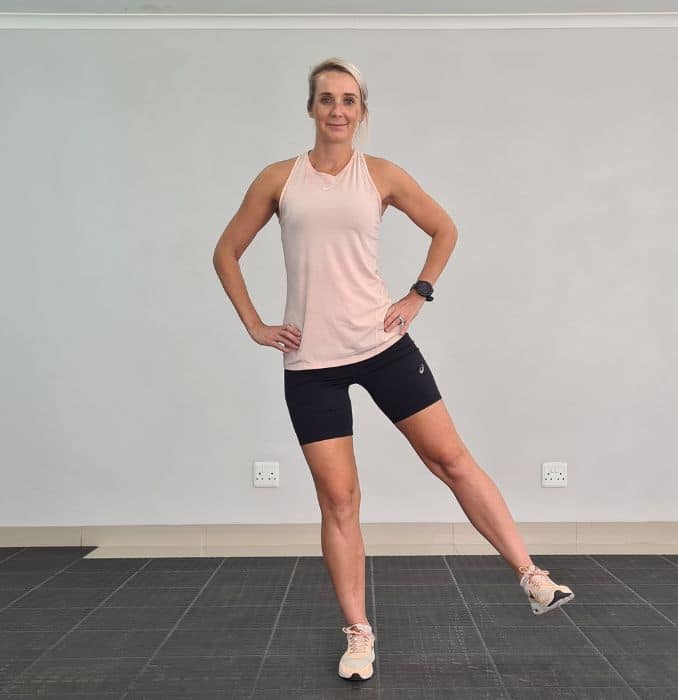 |
Lateral Leg Lifts
Repeat all the routine movements for 1 or 2 more sets depending on your comfort level.
Cool Downs
1. Figure 4
For this exercise, you can utilize a chair or a couch.
Begin in an upright sitting position on a chair with your feet flat on the floor, maintaining good alignment with your head, shoulders, and hips. Cross one ankle over your opposite knee. Engage your core and hinge through your hips to bend your upper body forward. Hold this position for several deep belly breaths, in through your nose and out through your mouth. Return to the starting position and repeat the movement on the opposite side.

Figure 4
2. Arms Overhead Stretch
Begin in an upright sitting position on a platform with your knees bent and feet flat on the floor, maintaining good alignment with your head, shoulders, and hips. Take a deep breath in, then bring your arms overhead with your palms facing toward the sky. Then, exhale as you lower your hands to return to the starting position.
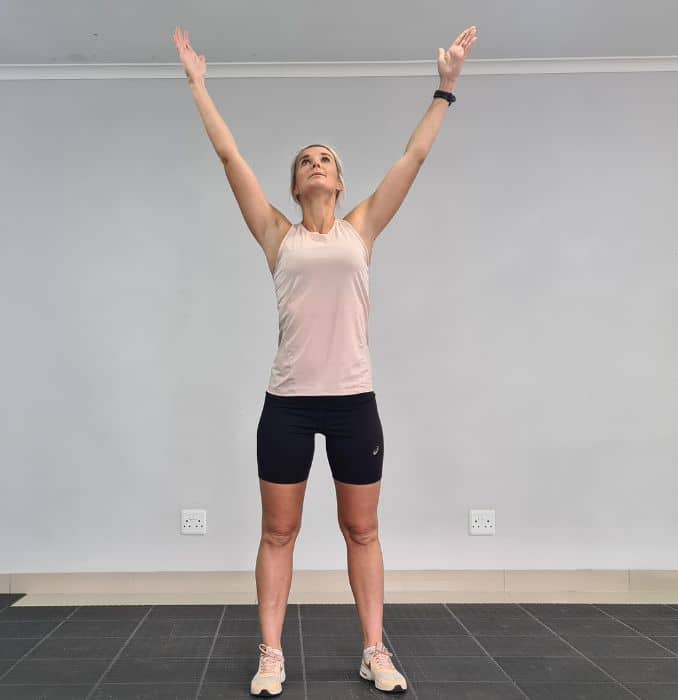
Arms Overhead Stretch
Some other good glute activations and strengthening exercises you can do at home or during work breaks are Bulgarian split squats and glute bridges. Performing these exercises with a resistance band or a medicine ball can even help intensify the stretch, tone, and strengthen the glutes.
Here are some steps to perform each exercise correctly:
Bulgarian Split Squats:
Begin with one foot on a bench or anything sturdy behind you while the other foot is planted firmly on the ground. Bent your front knee to lower your body down towards the ground. Keep your torso upright and your back straight throughout the movement. Repeat the movement on the other leg.
Glute Bridges:
Lie on your back on the floor with your knees bent and feet planted on the floor. Tighten your glutes and lift your hips up towards the sky, squeezing the glutes at the top position, then slowly lowering your hips back down to the floor.
Whenever you're in doubt, ask the assistance of a personal trainer before doing these exercises for your safety.
Tips for Maintaining Strong Glutes
Maintaining glute strength requires a combination of regular exercise, proper nutrition, and lifestyle habits. Here are some tips for keeping your glutes in shape:
1. Perform strength training exercises
Exercises like squats, lunges, and deadlifts are excellent for building and keeping your glutes strong. These gluthening exercises target the glute muscles and help to tone and strengthen them. Aim to perform these exercises at least 2-3 times a week.
2. Incorporate cardio
Cardiovascular exercise helps to reduce body fat, which can help to reveal the muscles in your glutes. Running, cycling, and stair climbing are all great cardio exercises that can help to keep your glutes toned.
3. Stretch before and after exercise
This can help to prevent injury and improve flexibility in your glute muscles. Try incorporating stretches like lunges, hip openers, and hamstring stretches into your pre-and post-workout routines.
4. Eat a balanced diet
A diet high in protein, good fats, and complex carbohydrates can support muscle building and fuel your workouts. For growing muscle, lean protein sources like chicken, fish, and tofu are excellent choices. At the same time, complex carbs like whole grains and sweet potatoes can provide energy for your workouts.
5. Practice good posture
Good posture is key to maintaining strong glutes. Long periods of sitting can lead to weak glutes and muscle imbalances. Try to sit up straight and engage your core and glutes throughout the day.
What are Glute Muscles
The glutes, also known as the gluteal muscles, are a group of three glute muscles that make up the buttocks – the gluteus maximus, gluteus medius, and gluteus minimus. These muscles are responsible for hip extension (moving your leg behind or when standing), hip abduction (moving your legs to the sides), and hip external rotation (moving your legs outward).
Functions of the glutes in everyday activities and exercise
Glutes play a significant role in maintaining posture, balance, and stability.
The gluteus maximus muscle is the largest in the body and is responsible for hip extension, which is essential for movements such as walking, running, and jumping. It also helps in the stabilization of the pelvis during these movements. In exercise, the gluteus maximus is targeted with squats, lunges, and deadlifts.
Hence, this is the largest and the most powerful muscle, it is crucial for treating gluteus maximus weakness through glute activation or strength training exercises.
On the other hand, the gluteus medius muscle is located on the outer surface of the pelvis, while the gluteus minimus muscle is located under the gluteus medius.
The gluteus medius and minimus are hip abductors. They are also responsible for various functions, such as stabilization of the pelvis during walking or running and maintaining balance.
Conclusion
Glute weakness can cause hip pain which must be addressed to prevent serious problems. Strengthening exercises or glute strengthening exercises are one of the best ways to address glute weakness, and it doesn't matter which muscles you work: lateral leg lifts, deadlifts, single leg deadlifts, or an elevated hip presses and glute kickbacks combo is going to bring results. These may not be the best glute strengthening exercises for others but for you.
Incorporating these five fun glute exercises into your workout routine will help you achieve stronger glutes and lower body, providing numerous benefits for your appearance and overall functionality.
Keep in mind that consistency is key. Make these glute strengthening exercises a regular part of your fitness routine, challenging yourself to push a little harder with each workout. As you progress, you'll be amazed at how your glutes will respond, becoming stronger, firmer, and more powerful.